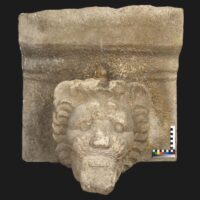 Excavations at the ancient Greek colony of Selinunte in Sicily have unearthed a rare marble lion’s head sima, a decorated spout meant to drain water from the roof of an ancient temple. It dates to the 5th century B.C.
Excavations at the ancient Greek colony of Selinunte in Sicily have unearthed a rare marble lion’s head sima, a decorated spout meant to drain water from the roof of an ancient temple. It dates to the 5th century B.C.
Almost two feet high, the figure is larger than usual for this type of architectural feature. It is also unfinished. The water outlet is not yet installed. The back of the mane and the top decoration is also incomplete.
It was discovered on a street near the ancient eastern harbor, an area known for its workshops. The lion was destined for one of Selinunte’s many temples, but never made it to the roof. It would have to have been a very fancy temple, however, as most simen of this era were made of terracotta.
“This marble was imported to Sicily from the Greek islands – probably from Paros,” says Jon Albers. “All in all, only nine temples from the 5th century BC are known to have a sima made of Greek marble in all of southern Italy and Sicily.” The roofs were mainly discovered in the 19th and early 20th centuries.
“The newly found Sima from Selinunte cannot be compared to any of these temples and is therefore part of a tenth temple with such a marble roof,” concludes Jon Albers. The researchers cannot yet decide whether the object was once intended for the well-known Temple E in Selinunte or for another monumental temple that is still unknown today. […]
Through this condition, the find allows us to to better understand the manufacturing processes for such architectural parts,” says the archaeologist happily. “Since the find comes from the port zone and the immediate vicinity of the workshop district of Selinunte, it allows further conclusions to be drawn about the city’s trade contacts and the technical skills of the ancient inhabitants of Selinunte.”